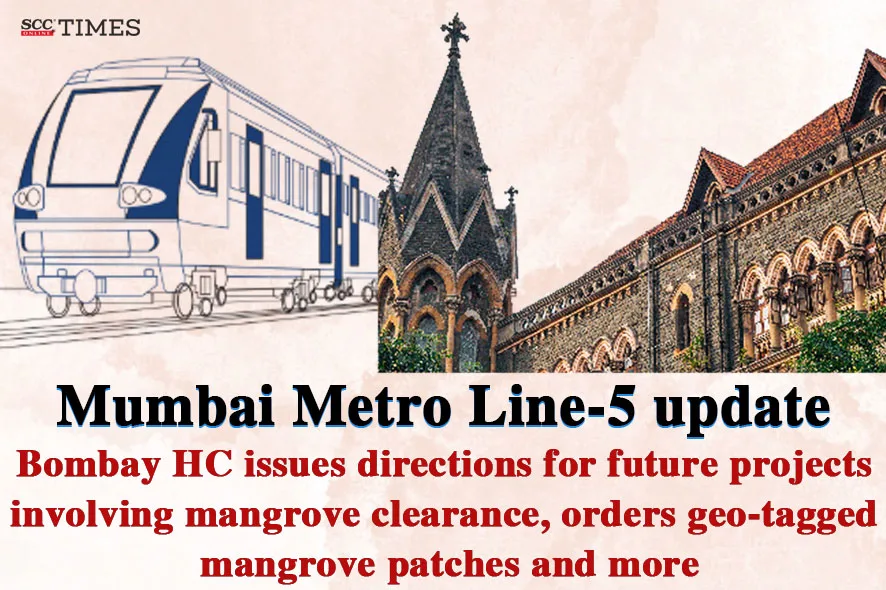Bombay High Court: Mumbai Metropolitan Region Development Authority (‘MMRDA’) filed the present petition seeking a direction to the respondents to permit it to proceed with the construction for the Mumbai Metro Line-5 project and keeping in mind its public importance, grant leave as contemplated under the various conditions imposed by the respondent authorities. The Division Bench of Revati Mohite Dere* and Dr. Neela Gokhale, JJ., while noting that the petition raised important questions concerning the balance between ecological preservation and infrastructure development, specifically requiring the cutting of mangroves for a public utility project, issued directions to be followed for all future projects involving cutting of mangroves, which included creating a dedicated website, geo-tagged and time-stamped proof of compensatory planting with periodic updates, etc.
Background:
The Mumbai Metro Line-5 (Thane-Bhiwandi-Kalyan) project involved the construction of a 24.90 km long Metro corridor, which included 16 stations (one station included in Metro-4) and a depot at Kasheli. MMRDA approached the Court regarding a condition imposed by the authorities that prior permission of the High Court must be obtained by the Project Proponent since the proposed construction of the towers fell within the 50-meter mangrove buffer zone and involved the cutting of mangroves. Various other conditions were also imposed by several authorities while granting the environmental clearance to construct the Kasheli Depot along with the Extra High Voltage (‘EHV’) towers and transmission lines for power supply to Receiving Sub-Station (‘RSS’) for the Mumbai Metro Line-5.
MMRDA sought for leave to be granted, as contemplated in the Specific Condition 2 imposed by Respondent 2-Maharashtra Coastal Zone Management Authority (‘MCZMA’), at Item 6, in its 174th Minutes of Meeting, and Specific Condition 4 in the CRZ Clearance dated 23-12-2024 and Specific Condition 1.10 in its letter dated 27-02-2025 granting Stage-I Forest Clearance under Van (Sanrakshan Evam Samvardhan) Adhiniyam, 1980 (‘Van Adhiniyam’), imposed by Respondent 1-Union of India, in view of the public importance of the project.
Analysis:
The Court highlighted that mangroves were ecologically fragile coastal ecosystems that served as natural barriers against erosion and flooding, protected marine biodiversity, and contributed significantly to climate resilience. Recognizing their ecological importance, mangroves were accorded legal protection under various statutes and judicial pronouncements. The Coastal Regulation Zone (‘CRZ’) Notification, issued under the Environment (Protection) Act, 1986, classified mangrove areas exceeding 1,000 square meters as CRZ-I(A), thereby prohibiting any developmental activity within such zones except with the prior approval and under stringent conditions. Similarly, under the Forest (Conservation) Act, 1980, read with the Van Adhiniyam, the felling of mangroves was regulated and could only be permitted upon satisfaction of compelling public interest, accompanied by appropriate compensatory afforestation measures. The judicial recognition of their importance was also affirmed in Bombay Environmental Action Group v. State of Maharashtra, 2018 SCC OnLine Bom 2680, wherein the Court invoked the public trust doctrine to hold that mangroves could not be destroyed for private, commercial or any other use, unless the Court found such action to be necessary in public interest.
The Court noted that although the authorities concerned had granted permission to cut 70 mangroves, MMRDA had proposed to cut only 26 mangroves. In respect of the 70 mangroves permitted to be cut, the respondent authorities were obligated to plant 370 mangrove saplings. The Court further noted that despite the permissions granted by the respondent authorities and the requisite payments made towards compensatory afforestation of mangroves, no parallel steps were taken by the authorities to implement the afforestation measures.
During the earlier hearings, Respondent 6-Bombay Environment Action Group (‘BEAG’) tendered certain suggestions regarding the protection and preservation of mangroves, and MMRDA also submitted suggestions for the issuance of guidelines concerning the protection and conservation of the mangroves. The Court also noted that for mangroves which were to be cut in Thane, compensatory afforestation was being done in Dhule which was 345 kms from Mumbai. But later Respondent 4 agreed to plant 370 mangrove saplings at Village Surai.
The Court had also appointed a Court Commissioner to verify whether there was sufficient area for planting saplings. The report he submitted stated that there was sufficient land and thereafter the Additional G.P. informed the Court that the channeling work had commenced, and the plantation of the saplings was expected to be completed by the end of September 2025. The authorities were also directed to create a dedicated website containing details of the project, amounts deposited, mangroves affected, including details of species of the trees to be felled and compensatory afforestation efforts undertaken.
The Court had opined that the concept of ‘sustainable development’ was a matter of great concern, whether for environmentalists or the Courts and there must not be development at the cost of environment and vice versa and that development could only take place after ensuring that as far as possible, the environment was safeguarded. The destruction of mangroves violated the fundamental rights of citizens under Article 21 of the Constitution, and that the State, its agencies, and instrumentalities were under a mandatory duty to protect and preserve mangroves under Articles 21, 47, 48A and 51A(g) of the Constitution.
Thus, in the present petition, the Court opined that where any development project involved the felling of mangroves or diversion of ecologically sensitive land, compensatory afforestation must not remain a formality or a mere post-facto measure. Instead, it must be enforced in a transparent manner, with a parallel condition for project execution. The Court condemned the practice of the Planning Authorities to approach the Court at the eleventh hour seeking urgent permissions for cutting of the trees and mangroves, while pressing that any delay would escalate project costs. The Court observed that the permissions for felling must be sought sufficiently in advance, and not at the last minute, so that afforestation steps could start well in advance.
The Court opined that project-related information must be publicly accessible, including permissions, conditions, maps, afforestation status, and monitoring mechanisms. Digitally verifiable and publicly accessible data, such as geo-tagged photographs and plantation updates, etc., were necessary to ensure accountability. The progress of mangroves, i.e. the saplings’ mortality rate, and the translocation of the trees, if done, also needed to be monitored. The Court observed that the monies deposited by the Development or Planning Authorities into the Compensatory Afforestation Fund (‘CAMPA’), must be utilised strictly for afforestation and conservation measures connected to the project for which such deposits were made, and not for any other project.
The Court further opined that it must be ensured that afforestation was not just undertaken but was done in a manner that meaningfully restored the ecological balance in the very regions that suffered degradation, rather than in distant areas where the environmental impact was negligible, and that it was imperative to create land banks, i.e., areas readily available where afforestation could be undertaken in future.
Decision:
Keeping in mind the above discussion, the Court disposed of the petition with the following directions:
-
MMRDA was permitted to begin the construction of Kasheli Depot and EHV towers for Metro Line 5, including the cutting of 26 mangroves, subject to compliance with the imposed conditions.
-
370—400 mangrove saplings must be planted by 30-09-2025 at Village Surai and more trees must be planted at Dhule.
-
The Planning Authority must bear the cost of fencing the plantation site.
-
General conditions for this and future projects involving mangrove or tree cutting:
-
Funds deposited by the project proponent must be used only for afforestation related to the specific project.
-
A public website must be launched within six weeks to host project details, approvals, affected flora, afforestation status, geo-tagged photos, compliance reports, and survival rates and the website must be updated every four months.
-
The land bank details for afforestation must be uploaded within eight weeks; the land must be duly fenced, mutated in favor of the Forest Department, and handed over to it.
-
For diversion exceeding 1-hectare, equivalent non-forest land must be identified, certified, acquired, and handed over to the Forest Department and for diversion less than 1-hectare, 10 times the number of trees proposed to be cut must be planted on degraded mangrove land in the same district.
-
The environmental approvals must be for the whole project and not in a piecemeal manner, and in case of any modifications in the project, fresh Environmental Impact Assessments must be conducted along with a revised conservation plan.
-
The afforestation sites must be near the affected areas as per Supreme Court’s decision in M.C. Mehta v. Union of India, 2024 SCC OnLine SC 5712.
-
No felling of the mangroves must be commenced until the afforestation began.
-
The Forest Department must give 7-days advance intimation to BEAG before carrying out the plantation.
-
All relevant documents must be publicly accessible on the Mangrove Cell website without login or registration.
-
All mangrove patches near the project sites must be geo-tagged and GIS-mapped.
-
The replantation must comply with the Forest Conservation Act, 1980 and the Rules of 2023 framed thereunder.
-
[MMRDA v. Union of India, Writ Petition No. 3727 of 2025, decided on 09-09-2025]
*Judgment authored by: Justice Revati Mohite Dere
Advocates who appeared in this case:
For the Petitioner: G. S. Hegde, Sr. Advocate a/w Saket Mone, Srushti Thorat and Fatema Kothari i/b Vidhii Partners.
Vishal Kanade as Amicus Curiae
For the Respondents: Pavan Patil a/w Tanmay Deshmukh and Soham Badole, Jaya Bagwe, O. A. Chandurkar, Addl. G.P., a/w Pooja Joshi Deshpande, A.G.P., Aditya Mehta a/w Deepali Bagla i/b Bagla and Associates.




